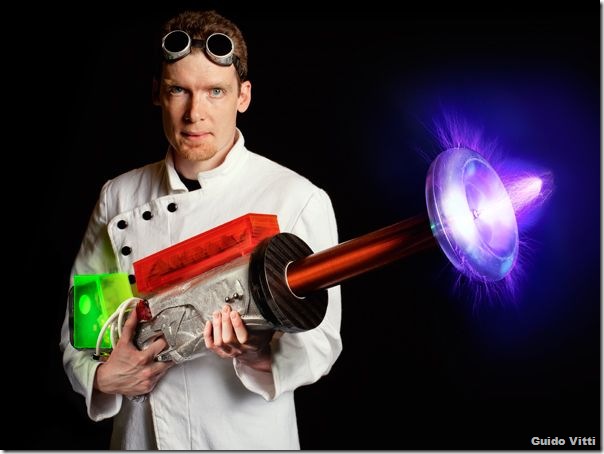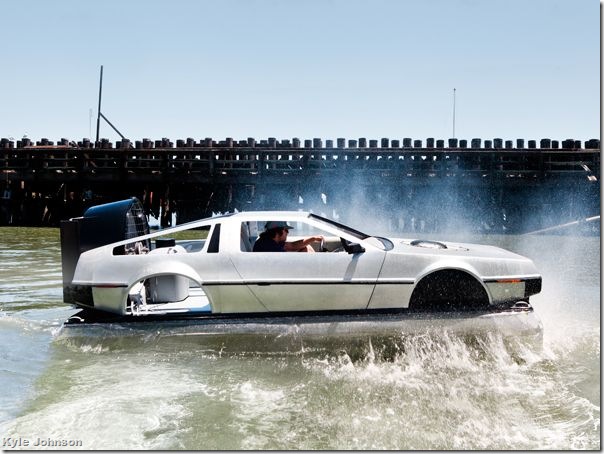
Backyard Genius: 10 Ingenious Amateur Builds for 2012
By Davin Coburn, Popular Mechanics, 5 September 2012.
By Davin Coburn, Popular Mechanics, 5 September 2012.
Tesla-themed Nerf gun? Check. Hovercraft DeLorean? You better believe it. Popular Mechanics' annual Backyard Genius list complies the cleverest, oddest, and coolest Do-It-Yourself projects from around the USA.
1. Nerf Tesla
Inventor: Rob Flickenger
Where: Seattle
Age: 37
Where: Seattle
Age: 37
This self-proclaimed mad scientist turned a Nerf gun into the ultimate sci-fi sidekick. "Not long ago, I picked up [the graphic novel] The Five Fists of Science, all about Nikola Tesla and Mark Twain battling the evil Thomas Edison," Flickenger says. "Tesla carries these steampunk guns that fire lightning bolts - I had to have one." Not even the sky-high voltage generated by a spark-gap tesla coil could deter him. A tech writer by day, Flickenger designed the porcelain-and-tungsten switch at the heart of the system on a 3D printer. The output is tied to a fly-back transformer from an old TV, and six Cornell Dubilier capacitors sit in a laser-cut housing atop the weapon. The device is powered by an 18-volt lithium-ion battery. When paired with the circuit nestled inside a PVC end cap, those 18 volts turn into nearly 200,000. "That capacitor bank could kill you twice before you hit the ground," Flickenger says. In other words, try not to play with it in the house.
2. Compact Go-Karts
Inventor: Charles Guan
Where: Cambridge, Massachusetts
Age: 23
Where: Cambridge, Massachusetts
Age: 23
Think of it as bringing horsepower to the people. On a whim last spring, the MIT masters student built a mini go-kart - or Chibikart - with custom-machined hub motors and a massive 33-volt lithium-ion battery. Amateur builders cheered the accomplishment online - and then furrowed their collective brow. "People were dismissing it as a privileged college kid project," Guan says. "So I decided to make a democratized version." Powered by a pair of standard 12-volt lithium iron phosphate batteries, the two-wheel-drive Chibikart 2 roams the school hallways on 4-inch rubber tires. The twin 1-hp drive motors were designed for RC model aircraft. "They're some of the best power-to-weight-ratio parts available for any kind of propulsion," Guan says. The 36-pound chariot stops thanks to brakes fashioned mostly from stock bicycle parts. Top speed? About 22 mph, which means Guan may want to think about buying himself a helmet.
[More information] [Charles Guan blog; Chibikart page (include video).] [More video]
3. Laser to Go
Inventor: Jessie Tank
Where: Anchorage, Alaska
Age: 34
Where: Anchorage, Alaska
Age: 34
Not long ago, Jessie Tank, who manages a computer store, found herself reflecting on the CO2 laser she had cobbled together with her father in high school. Before she knew it, she was re-creating the experience in her dining room. Her new laser uses a mixture of CO2, nitrogen, and helium sealed in a 13-mm glass tube from a neon-sign store. The gases are excited by electricity from a 400-watt variable transformer connected to an amp meter and mounted in a plastic toolbox. When the gas molecules collide, they release a beam of infrared light that bounces off two gold-and-zinc mirrors before zipping off in search of something to set on fire. "It's not strong enough to cut steel," Tank says of the beam, "but it's certainly enough to burn wood or paper. Or ignite gun powder - though I try to be considerate of the neighbours."
4. Homemade Seismology Lab
Inventor: Steve Jones
Where: Huntsville, Alabama
Age: 58
Where: Huntsville, Alabama
Age: 58
On Alabama's earthquake-tracking Web page, you'll find data from the state's official monitoring stations. Only one - the AlabamaQuake amateur seismic station - reports on the tremors from Steve Jones's basement. Ten years ago, the NASA engineer built his first seismometer: a Shackleford-Gundersen horizontal model. It was a fine place to start but nothing compared with his Inyo Force Balance Broadband Vertical seismometer. Machined from aluminium and brass, the device sits in a hermetically sealed pressure case with a thermal cover because the pendulum is so sensitive, the heat from a flashlight beam will set it off. "I can tell when the ground here moved 3 millimetres," Jones says. "We don't feel it, but it's fascinating to know when Huntsville shifts because of a quake in Japan."
[More information (include video)] [Steve Jones website]
5. Robo Tripod
Inventor: Arthur Wait
Where: Menlo Park, California
Age: 45
Where: Menlo Park, California
Age: 45
Let's face it: It's hard to broadcast yourself on YouTube when you're a one-man band. Who's going to hold the camera? Well, why not let Arthur Wait answer that for you. "YouTube has become more TV for me than TV is," says the software developer, who won the grand prize in Microsoft's Robotics @ Home Challenge. "There's a ton of great stuff there. It's a shame it's not always shot very well." With that in mind, the amateur photographer took a Parallax Eddie robot, a Kinect sensor, and Microsoft's Robotics Developer Studio and invented a roving tripod - one that rolls right alongside you, tilting and panning in response to certain hand gestures. This makes filming slightly more adventurous, of course. (Wait's walls have the nicks to prove it.) "But," he says, "once you understand what you're doing, you become a director." Even better, in that acceptance speech on Oscar night, you have no one but yourself to thank.
[More information: 1. SmartTripod to Replace Human Photographers? (include videos); 2. Microsoft announces Robotics @Home contest winner: a SmartTripod that can follow you.] [Arthur Wait's SmartTripod page on Google+]
6. Golden Gate II
Inventor: Larry Richardson
Where: Mulvane, Kansas
Age: 64
Where: Mulvane, Kansas
Age: 64
On his way to Vietnam in 1968, Larry Richardson caught a glimpse of the Golden Gate Bridge. Before shipping off, he picked up a postcard at the Army commissary. A year later, he returned home to Kansas. His wife, Barbara, put the postcard in a scrapbook, where it sat for 25 years - until the couple bought property with a creek. Using the postcard as a reference, Richardson took posts salvaged from a bridge, and cables from a plane and an oil rig and set to work with his aging father. "He and I had never been close," he says. "This let us bond." The 150-foot replica took seven years, $4000, and 97.5 tons of concrete to complete. In June, the retired postman boarded a plane for the first time since Vietnam. He returned to the Bay Area to show his wife his favourite landmark.
[More information (include video)]
7. The Snooki Silencer
Inventor: Matt Richardson
Where: Brooklyn, New York
Age: 30
Where: Brooklyn, New York
Age: 30
Blame it on Kim Kardashian. As TV coverage of the reality star's impending nuptials reached a fever pitch, Matt Richardson, a grad student in NYU's Interactive Telecommunications Program, decided to do something about it. He could have simply turned off the TV, of course, but where's the challenge in that? Instead, he rerouted the broadcast signal from the cable box into his Enough Already device, where a code he wrote scanned the closed captioning for offending language. (For Richardson, it was "Kardashian"-though "Red Sox," "election," and "Miami cannibal" work just as well.) When the system spots the trigger term, an Arduino board activates an LED. The bulb flashes the signal for "mute" and – voilà - you get celebutante-free airtime for 30 seconds. "You could also flip it around," Richardson says, "to turn the TV on if there's something you do want to hear about."
[More information (include video)]
8. No-Roads DeLorean
Inventor: Matt Riese
Where: San Francisco
Age: 28
Where: San Francisco
Age: 28
If you're going to take the time to build your own hovercraft, why not make it unique? After four years of effort, Matt Riese - a man of many odd jobs - is putting the finishing touches on this Back to the Future-inspired ride, fulfilling a DeLorean dream that began in middle school. "I'd done home remodelling but never a project like this," says the jack-of-all-trades. "When I stood back and looked at the first version, I realized I'd just kind of powered through it. So I decided to rebuild one part, then another. By the end I'd rebuilt almost everything." Based on Universal Hovercraft's UH-13PT Twin Trainer, Riese's silver star is sculpted from foam insulation covered in fiberglass. The doors and frame are reinforced with wood and aluminium. A lift motor inflates the air cushion, and a 16-hp horizontal-shaft engine at the rear stands in for "Doc" Brown's flux capacitor. The thing can easily ferry two people across flat land, but Riese didn't stop there: He made his DeLorean seaworthy too. Registered with the California DMV as a boat (it's not street-legal), the craft can travel close to 45 mph. That doesn't compete with Marty McFly's 88 mph - but it's plenty fast for a vehicle with no brakes.
[More information (include video)] [Delorean Hovercraft at Kickstarter]
9. Super Soaker Squirrel-Repellent System
Inventor: Kurt Grandis
Where: Chapel Hill, North Carolina
Age: 37
Where: Chapel Hill, North Carolina
Age: 37
He never planned to start a war. "I was playing around with Computer Vision to make a bird detector that could monitor what came to the feeder in our backyard," Kurt Grandis says. But what came was squirrels. So using a webcam and the recognition program, the software engineer conceived a tech-savvy solution to an age-old nuisance. First, he taught his laptop to identify and target each large, grey, fuzzy blob. Then he linked the computer to a Super Soaker mounted on a surveyor's tripod. After that it was simply a matter of placing the gun near the bird feeder and firing away. "The only problem," Grandis says, "was the squirrels were so active, they quickly drained the reservoir." No matter. Grandis and his family have since shifted the battlefield to a new home. "Now the problem is deer," he says. "I'm going to have to change things up a bit."
[More information (include video)] [Kurt Grandis blog]
10. Galactic Flight Trainer
Inventors: John Boyer, Joseph DeRose, Sam DeRose, Sam Frank, Alex Jacobson
Where: San Rafael, California
Ages: 8th grade to high school senior
Where: San Rafael, California
Ages: 8th grade to high school senior
Don't be deceived by those boyish smiles. These guys may look like plebes, but they're veteran hackers. Just ask the folks at Maker Faire. "We spent eight months on this project," Sam DeRose says. "But it was only recently that we looked back and said, 'Oh my God, that really worked.'" Built inside a Piper Cherokee fuselage scavenged for $400, the Do-It-Yourself flight simulator [The Viper] is modelled on the Colonial Viper aircraft from Battlestar Galactica. It has three screens that run the open-source FlightGear program. The Bay Area students wired the joystick-controlled software into 1-hp motors on the platform, allowing for 360-degree motion on the pitch and the roll axes. The five teens paid for the R&D with a Kickstarter campaign. "We play video games and that kind of stuff," says Sam, who will soon begin his studies at Harvey Mudd College. "But for me, being out in the garage building things is just something I have to do."
[More information (include video)] [The Viper website (include videos)] [The Viper at Kickstarter]










No comments:
Post a Comment
Please adhere to proper blog etiquette when posting your comments. This blog owner will exercise his absolution discretion in allowing or rejecting any comments that are deemed seditious, defamatory, libelous, racist, vulgar, insulting, and other remarks that exhibit similar characteristics. If you insist on using anonymous comments, please write your name or other IDs at the end of your message.